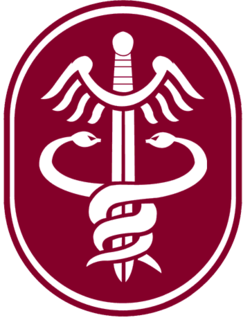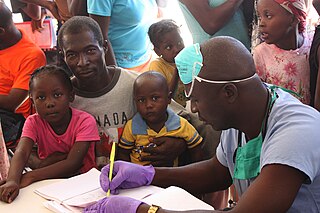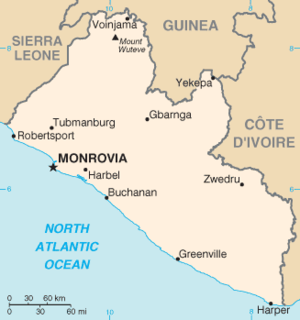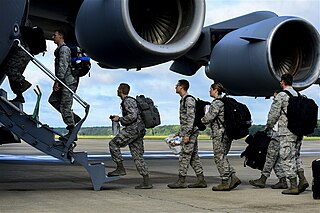
The U.S. Army Medical Command (MEDCOM) is a direct reporting unit of the U.S. Army that formerly provided command and control of the Army's fixed-facility medical, dental, and veterinary treatment facilities, providing preventive care, medical research and development and training institutions. On 1 October 2019, operational and administrative control of all military and veteran medical facilities transitioned to the Defense Health Agency.

The Walter Reed Army Medical Center (WRAMC) – known as Walter Reed General Hospital (WRGH) until 1951 – was the U.S. Army's flagship medical center from 1909 to 2011. Located on 113 acres (46 ha) in the District of Columbia, it served more than 150,000 active and retired personnel from all branches of the military. The center was named after Major Walter Reed (1851–1902), an Army physician who led the team that confirmed that yellow fever is transmitted by mosquitoes rather than direct contact.

A combat support hospital is a type of modern United States Army field hospital. The CSH is transportable by aircraft and trucks and is normally delivered to the Corps Support Area in standard military-owned demountable containers (MILVAN) cargo containers. Once transported, it is assembled by the staff into a tent hospital to treat patients. Depending upon the operational environment, a CSH might also treat civilians and wounded enemy soldiers. The CSH is the successor to the mobile army surgical hospital.

USNS Comfort (T-AH-20) is a Mercy-class hospital ship of the United States Navy.
Emergency is a humanitarian NGO that provides free medical treatment to the victims of war, poverty and landmines. It was founded in 1994. Gino Strada, one of the organisation's co-founders, served as EMERGENCY's Executive Director. It operates on the premise that access to high-quality healthcare is a fundamental human right.

Partners In Health (PIH) is a Boston-based nonprofit health care organization founded in 1987 by Paul Farmer, Ophelia Dahl, Thomas J. White, Todd McCormack, and Jim Yong Kim.

The David Grant USAF Medical Center (DGMC) at Travis Air Force Base in Fairfield, California, is the U.S. Air Force’s largest medical center in the continental United States and serves military beneficiaries throughout eight western states. It is a fully accredited hospital with a National Quality Approval gold seal by the Joint Commission, and serves more than 500,000 Department of Defense and Department of Veterans Affairs Northern California Health Care System eligible beneficiaries in the immediate San Francisco-Sacramento vicinity from 17 counties covering 40,000 square miles. DGMC is named in honor of Dr. David Norvell Walker Grant, USAAF, MC (1891-1964), the first Surgeon General of the U.S. Army Air Corps and U.S. Army Air Forces.

The Carl R. Darnall Army Medical Center is a United States Department of Defense medical facility at Fort Hood, Texas. It provides medical care to servicemembers and their families, along with veterans and their dependents, in and around the largest U.S. military installation in the world. Named after inventor of water chlorination Brigadier General Carl Rogers Darnall, MD., the core of the medical center is a state of the art 947,000-square-foot hospital. The facility opened in 2016, and includes a full primary care and emergency medical facility, including a level III trauma center, and specialized care in obstetrics and gynaecology, orthopedics, and behavioral health. The hospital provides treatment to nearly 3,000 patients daily. The medical center is one of the largest in the Military Health System, comprising more than 105 buildings in addition to the main facility, spread over Fort Hood, three local communities, and a clinic at the Red River Army Depot in Bowie County, Texas, outside of Texarkana. The medical center and its outlying facilities are staffed nearly entirely by uniformed servicemembers of the U.S. Army, however in 2019, the administrative control of the facility was shifted from United States Army Medical Command to the Defense Health Agency, an integrated joint Department of Defense combat support agency. All patients of the facility are insured and billed through Tricare, the health insurance system of the DoD. The medical center is led by Colonel Richard G. Malish.

The 59th Medical Wing (MDW) is the U.S. Air Force's largest medical wing and is the Air Force functional medical command for Joint Base San Antonio (JBSA). It comprises seven medical groups across San Antonio. Three are located at the Wilford Hall Ambulatory Surgical Center (WHASC); the 959th Medical Group is located at San Antonio Military Medical Center (SAMMC), JBSA-Fort Sam Houston; the 59th Training Group - the wing's newest group, activated on 4 January 2016, is also located at JBSA-Fort Sam Houston. The 359th and 559th Medical Groups are located at and support the missions of JBSA-Randolph and JBSA-Lackland, respectively.

Texas Health Presbyterian Hospital Dallas is a teaching hospital and tertiary care facility in the United States, located in the Vickery Meadow area of Dallas, Texas. It is the flagship institution of 29 hospitals in Texas Health Resources, the largest healthcare system in North Texas and one of the largest in the United States. The hospital, which opened in 1966, has 875 beds and around 1,200 physicians. The hospital is the largest business within Vickery Meadow. In 2008, the hospital implemented a program in which critical care physician specialists are available to patients in the medical and surgical intensive care units 24 hours a day, eliminating ventilator-associated pneumonia, central line infections and pressure ulcers. The hospital has maintained an active internal medicine residency training program since 1977, and hosts rotating medical students from University of Texas Southwestern Medical Center.
Nebraska Medicine, is a private not-for-profit American healthcare company based in Omaha, Nebraska. The company was created as Nebraska Health System (NHS) in 1997, when Bishop Clarkson Hospital merged with the adjacent University Hospital in midtown Omaha. Renamed The Nebraska Medical Center in 2003, in 2014 the company merged with UNMC Physicians and Bellevue Medical Center to become Nebraska Medicine. The company has full ownership of two hospitals and 39 specialty and primary care clinics in and around Omaha, with partial ownership in two rural hospitals and a specialty hospital. Nebraska Medicine's main campus, Nebraska Medicine – Nebraska Medical Center, has 718 beds, while its Bellevue Medical Center campus has 91 beds.

The 28th Combat Support Hospital was a Combat Support Hospital of the United States Army. It was first constituted in 1943 and served in China during World War II. During the Gulf War in 1990, it was the first Army hospital unit established and deployed into Iraq with combat forces of the XVIII Airborne Corps. More recently it has been involved in relief operations following natural disasters and has undertaken several recent deployments to Iraq. The unit fell under the command of the 44th Medical Brigade and was based at Fort Bragg, North Carolina.

The 10th Field Hospital is a Field Hospital of the United States Army first constituted on 23 June 1942 in the Army of the United States as the 10th Field Hospital.

An Ebola virus epidemic in Sierra Leone occurred in 2014, along with the neighbouring countries of Guinea and Liberia. On March 18, 2014 Guinean health officials announced the outbreak of a mysterious hemorrhagic fever "which strikes like lightning." It was identified as Ebola virus disease and spread to Sierra Leone by May 2014. The disease was thought to have originated when a child from a bat-hunting family contracted the disease in Guinea in December 2013.

An epidemic of Ebola virus disease occurred in Liberia from 2014 to 2015, along with the neighbouring countries of Guinea and Sierra Leone. The first cases of virus were reported by late March 2014. The Ebola virus, a biosafety level four pathogen, is an RNA virus discovered in 1976.

Four laboratory-confirmed cases of Ebola virus disease occurred in the United States in 2014. Eleven cases were reported, including these four cases and seven cases medically evacuated from other countries. The first was reported in September 2014. Nine of the people contracted the disease outside the US and traveled into the country, either as regular airline passengers or as medical evacuees; of those nine, two died. Two people contracted Ebola in the United States. Both were nurses who treated an Ebola patient; both recovered.

Organizations from around the world responded to the West African Ebola virus epidemic. In July 2014, the World Health Organization (WHO) convened an emergency meeting with health ministers from eleven countries and announced collaboration on a strategy to co-ordinate technical support to combat the epidemic. In August, they declared the outbreak an international public health emergency and published a roadmap to guide and coordinate the international response to the outbreak, aiming to stop ongoing Ebola transmission worldwide within 6–9 months. In September, the United Nations Security Council declared the Ebola virus outbreak in the West Africa subregion a "threat to international peace and security" and unanimously adopted a resolution urging UN member states to provide more resources to fight the outbreak; the WHO stated that the cost for combating the epidemic will be a minimum of $1 billion.

This article covers the timeline of the 2014 Ebola virus epidemic in West Africa and its outbreaks elsewhere. Flag icons denote the first announcements of confirmed cases by the respective nation-states, their first deaths, and their first secondary transmissions, as well as relevant sessions and announcements of agencies such as the World Health Organization (WHO), the U.S. Centers for Disease Control (CDC), and NGOs such as Doctors Without Borders; medical evacuations, visa restrictions, border closures, quarantines, court rulings, and possible cases of zoonosis are also included.

Operation United Assistance is a 2014 United States military mission to help combat the Ebola virus epidemic in West Africa, including the part of the epidemic occurring in Liberia. The 101st Airborne Division headquarters was responsible for leading the mission.

This articles outlines the defence forces of the European Union (EU), which implement the EU's Common Security and Defence Policy (CSDP) in CSDP missions. There are two categories of EU multinational forces: ones that have been established intergovernmentally and made available to the CSDP through article 42.3 of the Treaty on European Union (TEU), such as the Eurocorps; and the EU Battlegroups, established at the EU level.



















